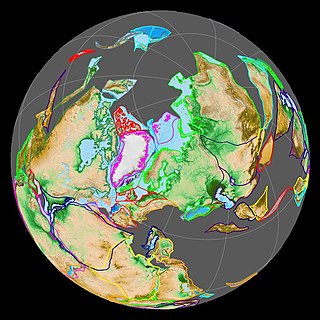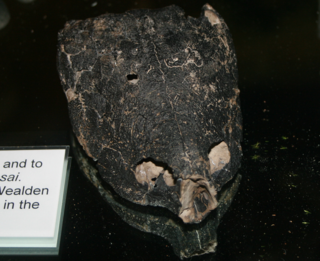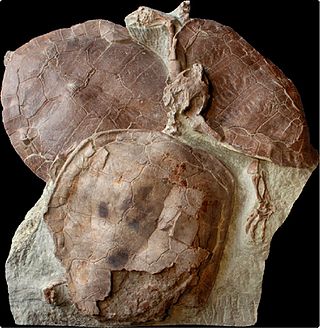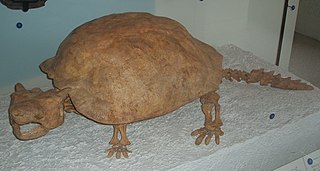
The Jurassic is a geologic period and stratigraphic system that spanned from the end of the Triassic Period 201.4 million years ago (Mya) to the beginning of the Cretaceous Period, approximately 145 Mya. The Jurassic constitutes the middle period of the Mesozoic Era and is named after the Jura Mountains, where limestone strata from the period were first identified.

Laurasia was the more northern of two large landmasses that formed part of the Pangaea supercontinent from around 335 to 175 million years ago (Mya), the other being Gondwana. It separated from Gondwana 215 to 175 Mya during the breakup of Pangaea, drifting farther north after the split and finally broke apart with the opening of the North Atlantic Ocean c. 56 Mya. The name is a portmanteau of Laurentia and Asia.

Paracryptodira is an extinct group of reptiles in the clade Testudinata, known from the Jurassic to Paleogene of North America and Europe. Initially treated as a suborder sister to Cryptodira, they were then thought to be a very primitive lineage inside the Cryptodira according to the most common use of the latter taxon. They are now often regarded as late-diverging stem-turtles, lying outside the clade formed by Cryptodira and Pleurodira. The paracryptodires are said to have phylogenic relationships, noted as primary subclades, within the Baenidae and Pleurosternidae. Within each subclade, lies many biodiverse turtles that are continuously being investigated and added to the fossil record. Paracryptodires are divided into three main groups, Compsemydidae, known from the Late Jurassic to Paleocene of North America and Europe, Pleurosternidae, known from the Late Jurassic to Early Cretaceous of North America and Europe, and Baenidae, known from the Early Cretaceous to Eocene of North America. The latter two groups are more closely related to each other than to Compsemys, forming the clade Baenoidea.
Sinemys is an extinct genus of turtle from the Late Jurassic to Early Cretaceous of China. Three species have been named: S. lens, the type species, from the Kimmeridgian-Tithonian of Shandong; S. gamera, from the Valanginian-Albian of Nei Mongol, and S. brevispinus from Early Cretaceous of Nei Mongol. S. wuerhoensis, from the Aptian-Albian of Xinjiang, is not referrable to this genus. Indeterminate specimen that may be belong to this genus is also known from Japan. The species S. gamera is noted for the presence of a pair of elongate spines projecting outwards and backwards from seventh costal of the carapace. These may have served a hydrodynamic function.

Paleontology or palaeontology is the study of prehistoric life forms on Earth through the examination of plant and animal fossils. This includes the study of body fossils, tracks (ichnites), burrows, cast-off parts, fossilised feces (coprolites), palynomorphs and chemical residues. Because humans have encountered fossils for millennia, paleontology has a long history both before and after becoming formalized as a science. This article records significant discoveries and events related to paleontology that occurred or were published in the year 2009.

The Ommatidae are a family of beetles in the suborder Archostemata. The Ommatidae are considered the extant beetle family that has most ancestral characteristics. There are only seven extant species, confined to Australia and South America. However, the geographical distribution was much wider during the Mesozoic spanning across Eurasia and Australia, suggesting that they were widespread on Pangea. So far, over 26 extinct genera containing over 170 species of these beetles have been described. Three extant genera have been assigned to this family: Omma,Tetraphalerus and Beutelius. The family is considered to be a subfamily of Cupedidae by some authors, but have been found to be more closely related to Micromalthidae in molecular phylogenies. A close relationship with Micromalthidae is supported by several morphological characters, including those of the mandibles and male genitalia. Due to their rarity, their ecology is obscure, it is likely that their larvae feed on deadwood.
Paleontology or palaeontology is the study of prehistoric life forms on Earth through the examination of plant and animal fossils. This includes the study of body fossils, tracks (ichnites), burrows, cast-off parts, fossilised feces (coprolites), palynomorphs and chemical residues. Because humans have encountered fossils for millennia, paleontology has a long history both before and after becoming formalized as a science. This article records significant discoveries and events related to paleontology that occurred or were published in the year 2010.
Amphilestidae is a family of Mesozoic mammals, generally regarded as eutriconodonts. They may form a paraphyletic or polyphyletic assemblage, though they share with gobiconodontids their similar tooth occlusion patterns and may be especially closely related to them. They occur from the Middle Jurassic to Cenomanian, and have a distribution across Laurasia.
Protoxinjiangchelys is an extinct genus of xinjiangchelyid turtle known from the Early to Late Jurassic of China. It is known from the single species P. salis, which was named and described in 2012. It contains only the holotype, ZDM 3009, which consists of a complete shell with an articulated carapace and a complete plastron and possibly another, older specimen.

Macrobaenidae is an extinct family of turtles, known from the Early Cretaceous to Paleogene of Laurasia. Their relationships to other turtles and whether they form a monophlyletic group are controversial. They are typically interpreted as stem or crown group cryptodires, but some more recent analyses have found them to lie outside crown group Testudines. Macrobaenids can be distinguished from other testudinatans by the presence of a carotid fenestra, cruciform plastron with strap-like epiplastra, and a lack of extragulars.

The Helochelydridae are an extinct family of stem-turtles known from fossils found in North America and Europe spanning the Early to Late Cretaceous.

Xinjiangchelyidae is an extinct family of turtles known from the Lower Jurassic to the Middle Cretaceous of Asia and western Europe. They have generally been interpreted as either being basal cryptodires or placed outside of crown Testudines.

Americhelydia is a clade of turtles that consists of sea turtles, snapping turtles, the Central American river turtle and mud turtles, supported by several lines of molecular work. Prior to these studies some morphological and developmental work have considered sea turtles to be basal members of Cryptodira and kinosternids related to the trionychians in the clade Trionychoidea. Americhelydia and Testudinoidea, both clades within Durocryptodira, split a part during the early Cretaceous.

Helochelydra is an extinct genus of extinct stem turtle known from the Early Cretaceous (Barremian) of the Isle of Wight, southern England.

Xinjiangchelys is an extinct genus of xinjiangchelyid turtle known from the Middle Jurassic to Early Cretaceous of China and Kyrgyzstan. It is known from over 11 different species.

The biogeography of Paravian dinosaurs is the study of the global distribution of Paraves through geological history. Paraves is a clade that includes all of the Theropoda that are more closely related to birds than to oviraptorosaurs. These include Dromaeosauridae and Troodontidae and Avialae. The distribution of paraves is closely related to the evolution of the clade. Understanding the changes in their distributions may shed light on problems like how and why paraves evolve, eventually gaining the ability to fly.

Perichelydia is a clade within Pantestudines known from the Middle Jurassic to Holocene. Alongside crown group Testudines, it also contains Helochelydridae, which is known from the Cretaceous of Europe and North America, Sichuanchelyidae from the Middle Jurassic to Paleocene of Asia and Europe, Meiolaniformes, which is known from the Cretaceous to Holocene of South America, Australia and Oceania, and Spoochelys, known from the Mid-Cretaceous Griman Creek Formation of Australia. Kallokibotion from the Late Cretaceous of Europe is also considered part of this group. Several other groups, including the proposed clade Angolachelonia, Paracryptodira, Macrobaenidae, Sinemydidae and Xinjiangchelyidae, which are sometimes considered members of Cryptodira, have also been found outside crown Testudines in several analyses. These groups are usually considered to be closer to the crown group than the other members of Perichelydia.

Mesochelydia is a clade within Pantestudines, more inclusive than Perichelydia, but less than Testudinata. The clade is known from the Early Jurassic to the Present, and contains all Jurassic representatives of Testudinata aside from Australochelys. The ancestral condition for Mesochelydia is thought to be aquatic, as opposed to terrestrial for Testudinata. They are distinguished from more basal testudinatans by the presence of the following characters: strap like pectoral girdle, supramarginals absent, reduced posterior entoplastral process, eleven pairs of peripherals, elongate processus interfenestralis, paired basioccipital tubercles, fully formed cavum tympani and antrum postoticum, single vomer, confluent external nares, lacrimals and supratemporals absent.
Paleontology or palaeontology is the study of prehistoric life forms on Earth through the examination of plant and animal fossils. This includes the study of body fossils, tracks (ichnites), burrows, cast-off parts, fossilised feces (coprolites), palynomorphs and chemical residues. Because humans have encountered fossils for millennia, paleontology has a long history both before and after becoming formalized as a science. This article records significant discoveries and events related to paleontology that occurred or were published in the year 2017.
This list of fossil reptiles described in 2016 is a list of new taxa of fossil reptiles that were described during the year 2016, as well as other significant discoveries and events related to reptile paleontology that occurred in 2016.















